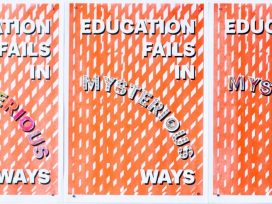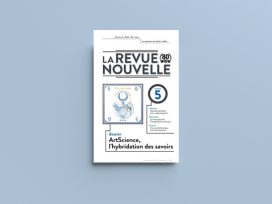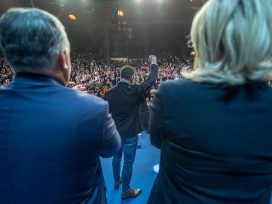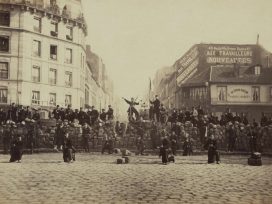Last year’s architectural Biennale in Venice came with the demand that ethics, and not only aesthetics, be once more taken into account in the building of the future. Your theme, Art For A Better Life, could be understood the same way. Max Frisch is in all the media at the moment. On this subject he once said: “Creating a work makes you liable.” Are we about to witness a normative turn in art?
Urs Lüthi: I don’t need a turn. I was shocked by the motto of the architectural Biennale. It implies a separation between ethics and aesthetics. I’ve been trying to resolve this opposition with my work for more than thirty years. For me, aesthetics is ethics. I see that as the basic decision behind all artistic creativity, a basic attitude. In art, ethics can only work by way of aesthetics.
Doris Krystof: Do you mean that in the sense of classical rhetoric, according to which the contents always need a packaging? That means, of course, that no effective art can do without a surface, regardless of whether we’re talking about questions of production, or strategies of persuasion.
Urs Lüthi: That’s exactly what I mean. Strangely, this compulsory connection – at least that’s how it seems to me – has been losing its significance, specifically in the last while. This interaction was absolutely self-evident to the modernists as well. Today, the economy and the consumer society are naturally taking over with open arms what art has given up in terms of normative claims. They are merciless in their use of the possibilities of surface and packaging to convey normative ideas. It’s been clear to them for a long time that the surface represents the perfect platform for any kind of message. We artists think we can simply give up this ground. I think that’s too bad, for one thing because it means giving up one of the most effective levels of communication. And for another, it’s ethically reckless to withdraw from this responsibility. After all, we want to give this world the kind of aesthetic design that makes it ethically more bearable.
Doris Krystof: And in fact, you can’t separate the two. It’s precisely good advertising that provides the best example of how to grab people right in their desires and wishes. It’s a virtuoso game of identities, of visions, of projections and productions.
Urs Lüthi: That’s exactly it. Art was advertising’s godfather. Advertising spent a long time in apprenticeship with us artists. Now it’s the other way around. Art is learning once again how to become an effective medium, and it’s learning it from the rituals of the mass media society. It’s sort of trying to win back what it gave up. Art as mimesis of the consumer world: that’s been the general trend since the sixties, since the beginnings of pop art.
Doris Krystof: And how do you position yourself on this issue? How do you see your approach to it? You work quite intentionally and consciously with a visual language that comes very close to advertising. You play with labels and displays, you even build images taken directly from advertising into your pieces.
Urs Lüthi: Of course. And it’s a suspenseful balancing act. You use the appropriate vocabulary, you play with it in order to unmask it, if you can. But I’m not interested in an evaluation in the sense of “good” or “bad.” Rather, I want to mirror the mechanisms and strategies that are effective in this context. And of course it would be nice if my viewers were moved to think about it themselves.
You speak of mimesis, and of a balancing act between art and advertising. You use the language and the iconography of advertising, and to some extent the strategies of the commercial world as well. But you also stake a claim for art’s independent ability to distinguish. In the end, art does want to bring forth an Other, to find an independent formulation. Or at least it tries to insist upon this Other in the sense of an ethical quality. How do you do this – with irony?
Urs Lüthi: You shouldn’t be able to rely on me. It’s important that, when you look at my pictures, you are permanently putting yourself in question, your position as a viewer, but also that you are questioning the statement made by the piece, as well as the artist’s attitude. It can’t be my task to offer certainties and meanings for you to do a piece of highwire interpretation. My work is about shifting meanings and blurring certainties. It’s part of the ethical function of the visual arts to stir up accustomed modes of viewing and evaluating. In the best of cases, the irritation catches up with me too, the artist. There’s an actual tradition there, since conceptual art and fluxus. Those things have always made me laugh. And that laughter, for its part, brings a level into play that is somewhere in the vague No Man’s Land between defensiveness and agreement. This ambivalence is a basic component of my work, the sine qua non. You can wring a deeper meaning out of the most banal statement, both in terms of design, and in terms of interpretation.
Doris Krystof: I actually find your work very funny. Humor seems to be a strong element of your process. That’s why I’d like to come back to the concept of irony. Irony has great potential as a design medium. But it’s a difficult: irony and humor have often been misunderstood by the tradition. I’m thinking for example of Yves Klein, who I think has to this day not been properly understood from this point of view.
Our way with irony – especially in the German-speaking world – is actually only natural under certain circumstances. We’re often blocked by seriousness, to this day. I remember an exhibit in Lucerne in 1970, “Visualized Thought Processes.” I was just 17 years old, we had discovered politics and critique in the wake of ’68. And here came this Urs Lüthi with an installation in which he made his own person the central theme. It irritated me and my friends, in the ambivalent sense of fascinating and repelling us. The way someone so baldly just evaded the codex of social critique, which had just come into effect, it made us think. Was that irony?
Urs Lüthi: Certainly in its effect. But it isn’t the case that I was serene and completely self-conscious when I put that exhibit together. I was swayed by exactly the same social winds myself, I was only 23, after all. I became the theme myself because I found the heroic attitude of the emerging political movement suspect. So in that sense it was certainly a conscious act, starting to direct attention to myself. I was beginning to see that there could not be a valid public truth. Intuitively, I had opposed by subject experience to the so-called social reality. Actually I can only do what is personally right for me. And I can only transmit this by way of myself, by way of my person as a mediator or a filter. It was true then and it’s all the more true now, in our modern media society. We may have more information, but we know less and less, because we are only conditionally able to bundle together all the data that streams in at us. And that’s why there was maybe more of a survival strategy behind my work at that time than there was irony.
Your contribution to the 1974 “Transformer” exhibit at the Lucerne art museum got the critics completely unnerved. How seriously were we to take these visual mutations of Urs Lüthi: what was artifact, and what was the artist’s real desire?
Urs Lüthi: They took it all too seriously at the time. I was just simply interested in how far a man could also be a woman. Transsexuality was not my subject, in the sense of a real reckoning with the human being’s corporeal transformability.
But from today’s perspective these works were incredible prescient about developments in the art business. Three decades later, there are symposia, publications, and exhibits all over the world on the topic of “body,” of self-production and role-playing, of personalities as synthetic concepts.
Urs Lüthi: In everything I have ever done there is an element of the contemporary mood. I am neither faster nor more independent than others. For a good ten years, since the early seventies, I have been intensely concerned with photography as a medium of perception and design. My “Selfportraits” and “Numbergirls” quickly became my actual trademark. Suddenly, everyone wanted a picture by me with my head on it. The Italians wanted nothing but these pictures, there was no demand for my still lifes of the same period. This one-sided reception quickly depressed me, I felt wasted and bored always having to do the same thing. For the first time I felt that unpleasant mechanism of the art market – I still dislike it – which measures the artist in terms of his recognizability. Be a good boy and do the same thing again. As long as it sells briskly. I was interested in something quite different. I wanted to get further. And, after ten years on this track, I didn’t see myself developing any more. But times had changed too. In Germany everybody was talking about the “Young Savages,” the “Junge Wilden.” Postmodernism was shaking away at established artistic concepts. Suddenly everyone wanted to start painting again. And as soon as I appeared with my paintings, the critics immediately started lamenting the fact that I too had succumbed to the trend. Today nobody would dream of connecting my paintings of the period with the dominant vocabulary of the time. Expressivity in the style of the “Junge Wilden” was totally alien to me. I never worked expressively in photography, either.
If one looks now at the 35 years of your artistic presence, it is striking that you have been able to successfully extract yourself every few years from every formal, stylistic, and media establishment. You are always near the heart of the times, but also always slightly off to the side. When one considers the whole ¦uvre, however, one senses an unbelievable coherence in your work, despite all the changes, the twists and the turns. You would yourself never think of eliding a phase of your production in retrospect. Quite the contrary. It seems actually part of your program to confront you new work with early pieces – almost as if you were continuously asking questions of yourself and your own work.
Urs Lüthi: One would in fact like to see one’s work as a great arc in terms of its design, rather than as a heap of innumerable separate pieces that have hardly anything to do with each other. But if you aim for this, you are in for a permanent process of self-interrogation, too. In the course of concrete work, you don’t know at first whether the current project will in any way go beyond this sort of piecemeal stuff. Actually all I do is heap together a lot of little splinters, set one piece against another and try to be as precise as possible in my individual pieces, always hoping that this precision of the particular will somehow enable me to catch a glimpse of the slightest sign of truth, which can in the end only achieve its effect in the whole work.
Doris Krystof: That is exactly what fascinates me so much about your work. Your choice of topics interrogates the issue of artistic authorship in the most varied fashion, it’s a constant questioning of your own artistic development, in fact, and in an incomparably ironic and even basically subversive way. (…)






